Holly Thompson's Blog, page 25
December 17, 2013
COETAIL: Creating Creative Writing Videos
Another post toward obtaining my Certificate in Educational Technology and Information Literacy (COETAIL)
With a family health situation requiring me to temporarily relocate to the U.S. midway through the Japanese university semester, I was recently tasked with handing over five of my six courses to substitute instructors and hurriedly determining which tasks and assessments I would maintain supervision of and which would be left to substitutes. My sixth course, Creative Writing--Fiction, is the one course that I will continue to teach solo, online, for the remainder of the semester.
I was actually eager to take on the challenge of converting a traditional face-to-face university course to an online format, though the compressed time frame for submitting detailed lesson plans to the dean and having to immediately create a Wiki and implement the plans was rather gray-hair inducing.
One challenge I created for myself was to commit to posting weekly class videos. Students will view a video at the beginning of each week's virtual class time. When submitting my plans for the online meetings of the course, I listed weekly videos with topics that were deliberately broad and open-ended-- outlining, character, details, revising and editing, etc., knowing that I may ultimately change to a more specific focus as I actually create each video.
My aim in creating these videos for my creative writing classes is to ensure that students continue to "see" me, feel connected to the course, and remain inspired and motivated to write innovative, original short fiction--even without the face-to-face class dynamics and direct peer and teacher reinforcement. The videos serve as one small component of the online classes.
Currently I am mulling my approach in these weekly videos. The first video about creating an outline or plot plan for a short story was simply of me talking to the students using iMovie--I gave a brief description of the assignment and elaborated on points explained on the Wiki. The second video was similar--me talking to the students about the assignment to do a character study of their story's main character. In the second video I added a few props. In both videos, I limited my speaking to under ten minutes--for my Japanese students this provides the right amount of listening practice without boring them, I hope, and reinforces the written guidelines and instructions on the class WikiSpaces site.
So . . . cringe . . . embarrassingly rough and goofy though it is, here is my class video on Character, created for my Japanese university creative writing students.
Obviously I'd like to be able to produce more polished and clever videos, but this is what I was able to accomplish under my present circumstances.
For one or two of the future videos I'd like to create some short tutorials, especially for demonstrating story editing and peer evaluation procedures. I will need to do some screen recording for those. I'm grateful for my COETAIL colleagues with their creative approaches and guidance in creating videos and tutorials; see this post from Student Centered Technology on "How to Create Video Tutorials"
I have a limited number of hours to devote to learning new techniques for creating these brief class videos, but I'll do my best. Feel free to share tips!
With a family health situation requiring me to temporarily relocate to the U.S. midway through the Japanese university semester, I was recently tasked with handing over five of my six courses to substitute instructors and hurriedly determining which tasks and assessments I would maintain supervision of and which would be left to substitutes. My sixth course, Creative Writing--Fiction, is the one course that I will continue to teach solo, online, for the remainder of the semester.
I was actually eager to take on the challenge of converting a traditional face-to-face university course to an online format, though the compressed time frame for submitting detailed lesson plans to the dean and having to immediately create a Wiki and implement the plans was rather gray-hair inducing.
One challenge I created for myself was to commit to posting weekly class videos. Students will view a video at the beginning of each week's virtual class time. When submitting my plans for the online meetings of the course, I listed weekly videos with topics that were deliberately broad and open-ended-- outlining, character, details, revising and editing, etc., knowing that I may ultimately change to a more specific focus as I actually create each video.
My aim in creating these videos for my creative writing classes is to ensure that students continue to "see" me, feel connected to the course, and remain inspired and motivated to write innovative, original short fiction--even without the face-to-face class dynamics and direct peer and teacher reinforcement. The videos serve as one small component of the online classes.
Currently I am mulling my approach in these weekly videos. The first video about creating an outline or plot plan for a short story was simply of me talking to the students using iMovie--I gave a brief description of the assignment and elaborated on points explained on the Wiki. The second video was similar--me talking to the students about the assignment to do a character study of their story's main character. In the second video I added a few props. In both videos, I limited my speaking to under ten minutes--for my Japanese students this provides the right amount of listening practice without boring them, I hope, and reinforces the written guidelines and instructions on the class WikiSpaces site.
So . . . cringe . . . embarrassingly rough and goofy though it is, here is my class video on Character, created for my Japanese university creative writing students.
Obviously I'd like to be able to produce more polished and clever videos, but this is what I was able to accomplish under my present circumstances.
For one or two of the future videos I'd like to create some short tutorials, especially for demonstrating story editing and peer evaluation procedures. I will need to do some screen recording for those. I'm grateful for my COETAIL colleagues with their creative approaches and guidance in creating videos and tutorials; see this post from Student Centered Technology on "How to Create Video Tutorials"
I have a limited number of hours to devote to learning new techniques for creating these brief class videos, but I'll do my best. Feel free to share tips!
Published on December 17, 2013 08:21
December 11, 2013
COETAIL: LINE Messaging App
Another post toward obtaining my Certificate in Educational Technology and Information Literacy (COETAIL)
This fall a colleague shared that he'd used the LINE messaging app during the major JALT conference to communicate with other conference organizers. Soon afterward, on my train commutes in Kanagawa and Tokyo, I realized I was seeing more and more commuter smartphones opened to LINE. Next, my university students working on a group project revealed that they were communicating with their group members using LINE. So I downloaded the app myself, noted that a number of my contacts were already using it, and began inquiring of friends: are you using LINE? At a glance, it seemed to me that those who were interacting with Japanese speakers were far more likely to be using LINE.
I decided to survey my students--at a public university in Japan.
Since I wanted to make sure all students responded, I handed out paper copies of the survey to students in five of my six classes. There were 61 respondents.
Here is the survey:
Loading...
Below are some of the results. Click to see the full results:
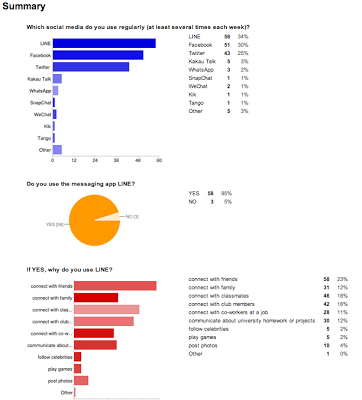 Partial results of Social Media Survey re. Messaging App LINE
Partial results of Social Media Survey re. Messaging App LINE
Of 61 student respondents, 58 use LINE. Most students use LINE as well as Facebook, and many use Twitter.
As this survey indicates, LINE is hugely popular in Japan, and also big in Thailand and Taiwan. See this recent Forbes article about the LINE success story.
For teachers it's always important for us to know the tools that students are using, and to consider ways in which such tools might be relevant to our classes. Certainly, for collaborative projects requiring work outside class time, LINE seems to be meaningful, as students commented that group communication is especially easy with LINE.
So, are you using LINE?
This fall a colleague shared that he'd used the LINE messaging app during the major JALT conference to communicate with other conference organizers. Soon afterward, on my train commutes in Kanagawa and Tokyo, I realized I was seeing more and more commuter smartphones opened to LINE. Next, my university students working on a group project revealed that they were communicating with their group members using LINE. So I downloaded the app myself, noted that a number of my contacts were already using it, and began inquiring of friends: are you using LINE? At a glance, it seemed to me that those who were interacting with Japanese speakers were far more likely to be using LINE.
I decided to survey my students--at a public university in Japan.
Since I wanted to make sure all students responded, I handed out paper copies of the survey to students in five of my six classes. There were 61 respondents.
Here is the survey:
Loading...
Below are some of the results. Click to see the full results:
 Partial results of Social Media Survey re. Messaging App LINE
Partial results of Social Media Survey re. Messaging App LINEOf 61 student respondents, 58 use LINE. Most students use LINE as well as Facebook, and many use Twitter.
As this survey indicates, LINE is hugely popular in Japan, and also big in Thailand and Taiwan. See this recent Forbes article about the LINE success story.
For teachers it's always important for us to know the tools that students are using, and to consider ways in which such tools might be relevant to our classes. Certainly, for collaborative projects requiring work outside class time, LINE seems to be meaningful, as students commented that group communication is especially easy with LINE.
So, are you using LINE?
Published on December 11, 2013 10:46
December 5, 2013
Wakame Season Hiatus
In Kamakura, the weather has been clear and cool, perfect for morning runs with clear views of Mt. Fuji.

All along the beach, the wakame ropes have been readied.

And this week the fishing families have been preparing the ropes for wakame cultivation.
 They've been taking tank-raised wakame sporophytes and twisting them into the ropes that will be set into the bay. Here's some video I shot this week.
They've been taking tank-raised wakame sporophytes and twisting them into the ropes that will be set into the bay. Here's some video I shot this week.
The wakame ropes will be set in the bay, and with the cool ebbing and flowing tides, those tiny wakame fronds will grow--up to one centimeter per day. The harvest will start in late January and continue until late March.
Winter in mild Kamakura has always been one of my favorite times of year. It's a season when I feel especially lucky to live by the sea in Japan.
But this week I've had to relocate to Boston to help care for a family member. As reluctant as I was to leave Japan at this time, sometimes family trumps all--work, writing, research. As I was struggling with preparations for being away from my home in Japan and my university teaching for two months, I realized that my time away will be roughly equal to the wakame growth period, that when I return to Kamakura, the wakame will be 1-2 meters long. It will be harvest time.
Somehow this image of the wakame growing all through this challenging time is a comfort to me. And so I'll consider this hiatus from Japan as a time of nurturing. While I'm here in Boston, I'll think of those wakame fronds in Japan growing longer and stronger day by day in the tides.

All along the beach, the wakame ropes have been readied.

And this week the fishing families have been preparing the ropes for wakame cultivation.
 They've been taking tank-raised wakame sporophytes and twisting them into the ropes that will be set into the bay. Here's some video I shot this week.
They've been taking tank-raised wakame sporophytes and twisting them into the ropes that will be set into the bay. Here's some video I shot this week.The wakame ropes will be set in the bay, and with the cool ebbing and flowing tides, those tiny wakame fronds will grow--up to one centimeter per day. The harvest will start in late January and continue until late March.
Winter in mild Kamakura has always been one of my favorite times of year. It's a season when I feel especially lucky to live by the sea in Japan.
But this week I've had to relocate to Boston to help care for a family member. As reluctant as I was to leave Japan at this time, sometimes family trumps all--work, writing, research. As I was struggling with preparations for being away from my home in Japan and my university teaching for two months, I realized that my time away will be roughly equal to the wakame growth period, that when I return to Kamakura, the wakame will be 1-2 meters long. It will be harvest time.
Somehow this image of the wakame growing all through this challenging time is a comfort to me. And so I'll consider this hiatus from Japan as a time of nurturing. While I'm here in Boston, I'll think of those wakame fronds in Japan growing longer and stronger day by day in the tides.
Published on December 05, 2013 07:38
December 2, 2013
Q&A on Random Buzzers
This week, Dec. 2-Dec. 6, I'm featured in the Random House Random Buzzers blog.

There is a Q&A Blog Buzz all about my novel The Language Inside currently posted. I'll be answering questions as and responding to comments as they come in. Drop by!

There is a Q&A Blog Buzz all about my novel The Language Inside currently posted. I'll be answering questions as and responding to comments as they come in. Drop by!
Published on December 02, 2013 15:40
November 24, 2013
Workshop: Writing Poetry for Children and Teens
This Saturday, November 30, I'm looking forward to presenting with poets Leza Lowitz and Mariko Nagai in an
SCBWI Japan
workshop on Writing Poetry for Children and Teens in Tokyo.

This evening workshop will feature three interesting poem categories:
Quest Poems with Leza Lowitz
History Poems with Mariko Nagai
and mine...
Action Poems with Holly ThompsonThere will be poetry packet handouts with poems in each of these three categories plus plenty of writing prompts for each category. Poets of all levels are welcome, from well-published to pre-published to newbies. Teachers and high school students are encouraged to join in as well.
Hope to see you there!

This evening workshop will feature three interesting poem categories:
Quest Poems with Leza Lowitz
History Poems with Mariko Nagai
and mine...
Action Poems with Holly ThompsonThere will be poetry packet handouts with poems in each of these three categories plus plenty of writing prompts for each category. Poets of all levels are welcome, from well-published to pre-published to newbies. Teachers and high school students are encouraged to join in as well.
Hope to see you there!
Published on November 24, 2013 04:17
November 23, 2013
COETAIL: Twine and Interactive Fiction
Another post toward obtaining my Certificate in Educational Technology and Information Literacy (COETAIL)
At the EARCOS weekend workshop Inspiring Learners Through STEM: Mindsets, The Maker Movement and Digital Culture at Yokohama International School feathering Adrian Camm, we discussed concepts of game based learning, considered game strategies, learned about some design projects with 3D printing, and worked on creating a text adventure game. As a creative writing, literature, and language teacher, I mulled how I might used these approaches in my classrooms.
Though I'm not a gamer, I've long been interested in interactive fiction, so when the weekend provided time for collaborative planning, with another cohort member, I opted to work with the program TWINE to create a branching story.
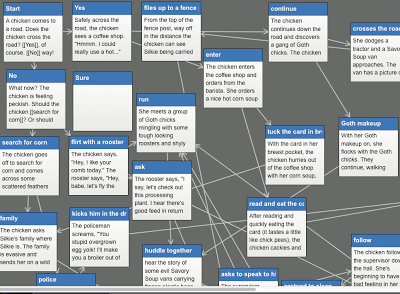
TWINE (see also @twinethreads) has a fairly short learning curve, and the coding is simple, and the Twinery.org Wiki offers help and tutorials.
I could quickly see that in a 1:1 creative writing classroom this would be a helpful tool for fiction writing students to create collaborative stories as a way to demonstrate the many different directions a story plot can take, or even to create individual short story or novel plot planning, with branching outlines allowing the author to view and compare the effectiveness of various outcomes in a story.
Here is the simple story Ted O'Neill and I created for our COETAIL exercise: A Chicken Story.

Note: To restart the story so that you can try different branches of the story, there are options to Rewind, Restart or Share beneath the Twine story title and author names (you have to cursor over them for them to show up against the black background). Click on Restart.
Though my university classrooms are not 1:1, I think that by using large sheets of paper and post-it notes in class for planning and mapping branches of the story in class, then uploading the results for the students to view, I can attempt a hybrid project of paper planning plus Twine upload for a group project in my creative writing class.
Stay tuned!
At the EARCOS weekend workshop Inspiring Learners Through STEM: Mindsets, The Maker Movement and Digital Culture at Yokohama International School feathering Adrian Camm, we discussed concepts of game based learning, considered game strategies, learned about some design projects with 3D printing, and worked on creating a text adventure game. As a creative writing, literature, and language teacher, I mulled how I might used these approaches in my classrooms.
Though I'm not a gamer, I've long been interested in interactive fiction, so when the weekend provided time for collaborative planning, with another cohort member, I opted to work with the program TWINE to create a branching story.

TWINE (see also @twinethreads) has a fairly short learning curve, and the coding is simple, and the Twinery.org Wiki offers help and tutorials.
I could quickly see that in a 1:1 creative writing classroom this would be a helpful tool for fiction writing students to create collaborative stories as a way to demonstrate the many different directions a story plot can take, or even to create individual short story or novel plot planning, with branching outlines allowing the author to view and compare the effectiveness of various outcomes in a story.
Here is the simple story Ted O'Neill and I created for our COETAIL exercise: A Chicken Story.

Note: To restart the story so that you can try different branches of the story, there are options to Rewind, Restart or Share beneath the Twine story title and author names (you have to cursor over them for them to show up against the black background). Click on Restart.
Though my university classrooms are not 1:1, I think that by using large sheets of paper and post-it notes in class for planning and mapping branches of the story in class, then uploading the results for the students to view, I can attempt a hybrid project of paper planning plus Twine upload for a group project in my creative writing class.
Stay tuned!
Published on November 23, 2013 22:50
November 16, 2013
Auction--Authors for the Philippines!
Act fast to provide relief to the Philippines--this auction closes Nov. 20! Authors for the Philippines is an online auction to raise money for the Red Cross Typhoon Haiyan Appeal.
The auction is now live and you can bid on all sorts of items and services--author visits to schools, books, manuscript critiques, character naming, mentoring and so much more.
I have donated an author visit by me to a school in Massachusetts or Japan--item #147, so spread the word to librarians and teachers in MA and Japan . . .
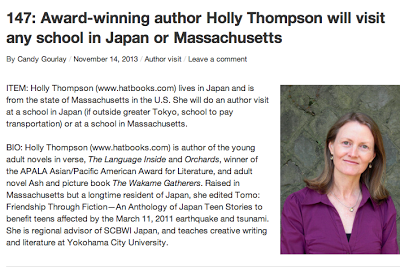
I've also donated a set of my young adult books--item #349 (scroll down that page to see the item).
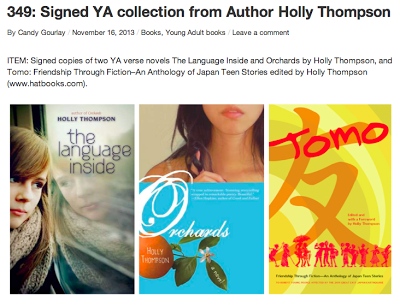
So bid high on these and other items and help the Philippines--your money goes directly to the Red Cross Typhoon Haiyan Appeal.

Thank you!
The auction is now live and you can bid on all sorts of items and services--author visits to schools, books, manuscript critiques, character naming, mentoring and so much more.
I have donated an author visit by me to a school in Massachusetts or Japan--item #147, so spread the word to librarians and teachers in MA and Japan . . .

I've also donated a set of my young adult books--item #349 (scroll down that page to see the item).

So bid high on these and other items and help the Philippines--your money goes directly to the Red Cross Typhoon Haiyan Appeal.

Thank you!
Published on November 16, 2013 14:51
November 14, 2013
COETAIL: Blog Experiment--Going Visual
Another post toward obtaining my Certificate in Educational Technology and Information Literacy (COETAIL)
During COETAIL Course 3 which focused on visual literacy, I updated this HATBOOKS blog--or so I thought. I was tired of the narrow format I'd been working with, which made embedding videos a real challenge, and I wanted photos to pop more. I shifted to this Blogger Dynamic Views template, which seemed like a perfect solution.
 New HATBOOKS blog as viewed with ChromePros
New HATBOOKS blog as viewed with ChromePros
I liked the fact that suddenly a visitor could peruse my posts visually, not just by tag clouds or post titles or dates. I loved how a visitor could click to select Recent, Date, Label to find posts. I loved how the flipcard images shifted and move into those groupings. Of course, I realized that to make the best use of this format, in creating future posts, I'd need to carefully select the first photo for each post, since that would be the one shown in the thumbnail (it does not seem possible to select which image to showcase). I also realized I'd need to shorten my post titles, but overall I loved the visual impact and this new face for my blog.
Cons
The flipcard action can drive you crazy when you try to flip the image squares to the actual post--you have to click just so, a bit to the right side of center. But the biggest con was that it seemed that this template was fine with Safari and Firefox, but not with Chrome.
 HATBOOKS blog as viewed with FirefoxAn entire menu that appeared in the upper left when viewing with Firefox was completely absent when the blog was viewed with Chrome. For me, an author/educator, this menu is critical--including pages for Books, Website and Contact.
HATBOOKS blog as viewed with FirefoxAn entire menu that appeared in the upper left when viewing with Firefox was completely absent when the blog was viewed with Chrome. For me, an author/educator, this menu is critical--including pages for Books, Website and Contact.
Further, with Chrome, the comments feature disappeared entirely, so visitors using Chrome (such as my course instructor--yikes!) had no way of leaving comments on the post.
See how the end of the post looked when viewed with Chrome:
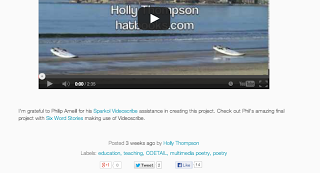
See how it looked when viewed with Firefox:

This was all especially puzzling since Blogger is Google's weblog publishing tool. Ahem, Google! I was left with a dilemma. Leave it as it was and lose or frustrate the Chrome users? Change to a new template?
Eventually, online searches about this problem let me to this fix for the Blogger Dynamic Views.
I made the fix and it seems to work. But questions loom about Google strategies--ending Google Reader, making Blogger Dynamic Views problematic unless bloggers add HTML code--why? Why alienate Google users?
For now, though, it seems, my blog is viewable regardless of the browser. Hooray! So, what do you think about this Dynamic View for HATBOOKS?
During COETAIL Course 3 which focused on visual literacy, I updated this HATBOOKS blog--or so I thought. I was tired of the narrow format I'd been working with, which made embedding videos a real challenge, and I wanted photos to pop more. I shifted to this Blogger Dynamic Views template, which seemed like a perfect solution.
 New HATBOOKS blog as viewed with ChromePros
New HATBOOKS blog as viewed with ChromeProsI liked the fact that suddenly a visitor could peruse my posts visually, not just by tag clouds or post titles or dates. I loved how a visitor could click to select Recent, Date, Label to find posts. I loved how the flipcard images shifted and move into those groupings. Of course, I realized that to make the best use of this format, in creating future posts, I'd need to carefully select the first photo for each post, since that would be the one shown in the thumbnail (it does not seem possible to select which image to showcase). I also realized I'd need to shorten my post titles, but overall I loved the visual impact and this new face for my blog.
Cons
The flipcard action can drive you crazy when you try to flip the image squares to the actual post--you have to click just so, a bit to the right side of center. But the biggest con was that it seemed that this template was fine with Safari and Firefox, but not with Chrome.
 HATBOOKS blog as viewed with FirefoxAn entire menu that appeared in the upper left when viewing with Firefox was completely absent when the blog was viewed with Chrome. For me, an author/educator, this menu is critical--including pages for Books, Website and Contact.
HATBOOKS blog as viewed with FirefoxAn entire menu that appeared in the upper left when viewing with Firefox was completely absent when the blog was viewed with Chrome. For me, an author/educator, this menu is critical--including pages for Books, Website and Contact.Further, with Chrome, the comments feature disappeared entirely, so visitors using Chrome (such as my course instructor--yikes!) had no way of leaving comments on the post.
See how the end of the post looked when viewed with Chrome:

See how it looked when viewed with Firefox:

This was all especially puzzling since Blogger is Google's weblog publishing tool. Ahem, Google! I was left with a dilemma. Leave it as it was and lose or frustrate the Chrome users? Change to a new template?
Eventually, online searches about this problem let me to this fix for the Blogger Dynamic Views.
I made the fix and it seems to work. But questions loom about Google strategies--ending Google Reader, making Blogger Dynamic Views problematic unless bloggers add HTML code--why? Why alienate Google users?
For now, though, it seems, my blog is viewable regardless of the browser. Hooray! So, what do you think about this Dynamic View for HATBOOKS?
Published on November 14, 2013 20:13
Blog Experiment--Going Visual
Another post toward obtaining my Certificate in Educational Technology and Information Literacy (COETAIL)
During COETAIL Course 3 which focused on visual literacy, I updated this HATBOOKS blog--or so I thought. I was tired of the narrow format I'd been working with, which made embedding videos a real challenge, and I wanted photos to pop more. I shifted to this Blogger Dynamic Views template, which seemed like a perfect solution.
 New HATBOOKS blog as viewed with ChromePros
New HATBOOKS blog as viewed with ChromePros
I liked the fact that suddenly a visitor could peruse my posts visually, not just by tag clouds or post titles or dates. I loved how a visitor could click to select Recent, Date, Label to find posts. I loved how the flipcard images shifted and move into those groupings. Of course, I realized that to make the best use of this format, in creating future posts, I'd need to carefully select the first photo for each post, since that would be the one shown in the thumbnail (it does not seem possible to select which image to showcase). I also realized I'd need to shorten my post titles, but overall I loved the visual impact and this new face for my blog.
Cons
The flipcard action can drive you crazy when you try to flip the image squares to the actual post--you have to click just so, a bit to the right side of center. But the biggest con was that it seemed that this template was fine with Safari and Firefox, but not with Chrome.
 HATBOOKS blog as viewed with FirefoxAn entire menu that appeared in the upper left when viewing with Firefox was completely absent when the blog was viewed with Chrome. For me, an author/educator, this menu is critical--including pages for Books, Website and Contact.
HATBOOKS blog as viewed with FirefoxAn entire menu that appeared in the upper left when viewing with Firefox was completely absent when the blog was viewed with Chrome. For me, an author/educator, this menu is critical--including pages for Books, Website and Contact.
Further, with Chrome, the comments feature disappeared entirely, so visitors using Chrome (such as my course instructor--yikes!) had no way of leaving comments on the post.
See how the end of the post looked when viewed with Chrome:

See how it looked when viewed with Firefox:

This was all especially puzzling since Blogger is Google's weblog publishing tool. Ahem, Google! I was left with a dilemma. Leave it as it was and lose or frustrate the Chrome users? Change to a new template?
Eventually, online searches about this problem let me to this fix for the Blogger Dynamic Views.
I made the fix and it seems to work. But questions loom about Google strategies--ending Google Reader, making Blogger Dynamic Views problematic unless bloggers add HTML code--why? Why alienate Google users?
For now, though, it seems, my blog is viewable regardless of the browser. Hooray! So, what do you think about this Dynamic View for HATBOOKS?
During COETAIL Course 3 which focused on visual literacy, I updated this HATBOOKS blog--or so I thought. I was tired of the narrow format I'd been working with, which made embedding videos a real challenge, and I wanted photos to pop more. I shifted to this Blogger Dynamic Views template, which seemed like a perfect solution.
 New HATBOOKS blog as viewed with ChromePros
New HATBOOKS blog as viewed with ChromeProsI liked the fact that suddenly a visitor could peruse my posts visually, not just by tag clouds or post titles or dates. I loved how a visitor could click to select Recent, Date, Label to find posts. I loved how the flipcard images shifted and move into those groupings. Of course, I realized that to make the best use of this format, in creating future posts, I'd need to carefully select the first photo for each post, since that would be the one shown in the thumbnail (it does not seem possible to select which image to showcase). I also realized I'd need to shorten my post titles, but overall I loved the visual impact and this new face for my blog.
Cons
The flipcard action can drive you crazy when you try to flip the image squares to the actual post--you have to click just so, a bit to the right side of center. But the biggest con was that it seemed that this template was fine with Safari and Firefox, but not with Chrome.
 HATBOOKS blog as viewed with FirefoxAn entire menu that appeared in the upper left when viewing with Firefox was completely absent when the blog was viewed with Chrome. For me, an author/educator, this menu is critical--including pages for Books, Website and Contact.
HATBOOKS blog as viewed with FirefoxAn entire menu that appeared in the upper left when viewing with Firefox was completely absent when the blog was viewed with Chrome. For me, an author/educator, this menu is critical--including pages for Books, Website and Contact.Further, with Chrome, the comments feature disappeared entirely, so visitors using Chrome (such as my course instructor--yikes!) had no way of leaving comments on the post.
See how the end of the post looked when viewed with Chrome:

See how it looked when viewed with Firefox:

This was all especially puzzling since Blogger is Google's weblog publishing tool. Ahem, Google! I was left with a dilemma. Leave it as it was and lose or frustrate the Chrome users? Change to a new template?
Eventually, online searches about this problem let me to this fix for the Blogger Dynamic Views.
I made the fix and it seems to work. But questions loom about Google strategies--ending Google Reader, making Blogger Dynamic Views problematic unless bloggers add HTML code--why? Why alienate Google users?
For now, though, it seems, my blog is viewable regardless of the browser. Hooray! So, what do you think about this Dynamic View for HATBOOKS?
Published on November 14, 2013 20:13
October 25, 2013
COETAIL: Wrong Way Right--A Dyslexic Lament
Another post toward obtaining my Certificate in Educational Technology and Information Literacy (COETAIL)
For my COETAIL Course 3 final project, toward teaching workshops on multimedia poetry with students, I worked on a visual poem stemming from my own mild dyslexic tendencies and frustrations. I've never been officially tested, but if I were, I'm quite sure the results would indicate some degree of dyslexia.
In Japan, despite evidence to the contrary, I've actually been told, "We don't have dyslexia here," but the reality is that dyslexia, as well as other learning disorders, is often simply never diagnosed or not diagnosed until adulthood (see this Asahi Shimbun article Dyslexic People Spread Awareness About the Disorder). Although kanji characters may be, in general, easier for dyslexics to read (see the Wall Street Journal piece Unlocking Dyslexia in Japanese), dyslexia does exist in Japan, and is not uncommon.
For this poetry project I would have loved to play with kinetic typography, but there's a steep learning curve for that, and there was a deadline for this COETAIL project. Plus, a designer brain is generally required for kinetic typography. This video of the poem "Speak With Conviction" by Taylor Mali with typography by Ronnie Bruce, is one of my favorites.
So, lacking kinetic typography skills, I turned to iMovie and played with movement of English words and Japanese kanji and katakana. Here's the result: "Wrong Way Right: A Dyslexic Lament."
I'm grateful to Philip Arneill for his Sparkol Videoscribe assistance in creating this project. Check out Phil's amazing final project with Six Word Stories making use of Videoscribe.
For my COETAIL Course 3 final project, toward teaching workshops on multimedia poetry with students, I worked on a visual poem stemming from my own mild dyslexic tendencies and frustrations. I've never been officially tested, but if I were, I'm quite sure the results would indicate some degree of dyslexia.
In Japan, despite evidence to the contrary, I've actually been told, "We don't have dyslexia here," but the reality is that dyslexia, as well as other learning disorders, is often simply never diagnosed or not diagnosed until adulthood (see this Asahi Shimbun article Dyslexic People Spread Awareness About the Disorder). Although kanji characters may be, in general, easier for dyslexics to read (see the Wall Street Journal piece Unlocking Dyslexia in Japanese), dyslexia does exist in Japan, and is not uncommon.
For this poetry project I would have loved to play with kinetic typography, but there's a steep learning curve for that, and there was a deadline for this COETAIL project. Plus, a designer brain is generally required for kinetic typography. This video of the poem "Speak With Conviction" by Taylor Mali with typography by Ronnie Bruce, is one of my favorites.
So, lacking kinetic typography skills, I turned to iMovie and played with movement of English words and Japanese kanji and katakana. Here's the result: "Wrong Way Right: A Dyslexic Lament."
I'm grateful to Philip Arneill for his Sparkol Videoscribe assistance in creating this project. Check out Phil's amazing final project with Six Word Stories making use of Videoscribe.
Published on October 25, 2013 08:52



